
by Jennifer Prestholdt (USA) | Dec 10, 2013 | Education, Family, Human Rights, International, United Nations

Every December 10, people around the world celebrate Human Rights Day. The date was chosen to honor the United NationsGeneral Assembly‘s adoption on 10 December 1948 of the Universal Declaration of Human Rights (UDHR), the first global statement of international human rights principles.
As we have done on World Moms Blog before (see 10 Things to Do With Your Kids on Human Rights Day), we’re sharing some ideas for simple yet meaningful ways for your family to celebrate the rights and responsibilities that we all share as human beings.
1. Make a World Wishes Dove with your family. Cut feathers from white paper or colored construction paper. Have everyone in the family decorate and write their wish for the world on a feather. Cut out the body of a dove or other bird and glue all the feathers on it. Once decorated, your bird will be a beautiful and hopeful expression of your family’s hopes for our world.
2. Play a game that helps kids understand human rights. Blind Trust (from ABC – Teaching Human Rights): In pairs, have one child blindfold the other and have the sighted member of the pair lead the “blind” one about for a few minutes. Make sure the leading child is not abusing the power to lead, since the idea is to nurture trust, not to destroy it. The “leader” of the pair should try to provide as wide a variety of experiences as possible, such as having the “blind” partner feel things with his or her feet or fingers, leading with vocal directions or even playing a game. After a few minutes have the children reverse the roles and repeat the process so that the “leader” is now the led, and the “blind” partner is now the sighted one.
Once the activity is over, allow the children to talk about what happened. Discuss how they felt – not just as “blind” partners but their feelings of responsibility as “leaders” too. This can lead not only to a greater awareness of what life is like for people with sight (or hearing) disabilities, but to a discussion of the importance of trust in the whole community. This can lead in turn to a discussion of world society, how it works and how it can fail to work too. (teaches about Universal Declaration of Human Rights article 28; Convention on the Rights of the Child articles 3, 23)
3. Learn about how children live in other countries. For example, you can learn what kinds of food children in East Africa grow and eat from the Lessons from Africa resource created by the British non-governmental organization Send A Cow (also check out their website www.cowforce.com). You can download the powerpoint about typical East African food. You can also print out some of the recipes for things like chapatis and pepper soup to make and try for yourself.
4. Find out what kids and teens can do to help stop child labor. The ILO’s Youth in Action against Child Labour campaign has ideas, information, videos and other resources to help young people take action to end child labor.
5. Play Human Rights Twister to teach about cooperation, respect and inclusion. Make a “Twister” game in which kids spell out key human rights words using their feet and hands. Draw a grid with 6 columns and 5 rows with marker on a large piece of cloth (like an old sheet) or plastic (like a plastic tablecloth). You can also use chalk to draw it on the ground. Write the following letters in the grid:
(blank) W X Y Z(blank)
Q R S T U V
K L M N O P
E F G H I J
(blank space)A B C D(blank)
Ask the children to name some rights and list them on a large piece of paper or whiteboard. Underline a key word in each right from this list of rights in one word:
Dignity Education Equality Food Freedom Home Love (from parents) Name
Nationality Opinion Participation (in decisions that affect us) Play Protection Religion
When you have listed at least 3 or 4 rights, have the children spell out the key word in the human right from the list by placing their hands and feet on the appropriate letters of the “Twister” game. When 1 child’s hands and feet are in place and the word is not yet completed, ask another child to join in to complete the word. If the hand or foot of another child already covers a letter, the player just has to touch the child that is on that letter. When a letter is too far to reach, invite another child to join in. (This activity and dozens of others to teach about human rights values and peaceful conflict resolution are available for free download in the Canadian organization Equitas‘ Play It Fair Toolkit. )
6. Make toys and play games that children play in other countries.
Many kids throughout the world live in poverty and don’t have money to buy toys and games. They make their own toys out of recycled materials that they find. Your kids can try making a football (soccer ball) out of recycled plastic bags or a toy car made from a plastic bottle.
http://vimeo.com/39763894
You can also make and play the Sudanese game “Dala” (the Cow Herder Game). In many parts of the world, games mimic everyday life; this game mimics the Sudanese practice of bull herding. Sudanese people play it on the ground, using sticks to make the lines and pebbles or seeds as “bulls”.
7. Ask the question “What Does a Child Need?” Have your child lie down on a large piece of paper and trace their outline on the paper. Ask your child(ren) to name this paper child. Discuss and decide on the mental, physical, spiritual and character qualities they want this ideal child to have as an adult (e.g. good health, sense of humour, kindness) and write these qualities inside the outline. They might also make symbols on or around the child to represent these ideal qualities (e.g. books to represent education). Talk about what human and material resources the child will need to achieve these qualities (e.g. if the child is to be healthy, it will need food and health care); write them down on the paper outside of the outline. You can also read a simplified version of the Convention on the Rights of the Child (available in English, French, Spanish, Russian, German, etc.) When children hear an article that guarantees a child each of the needs they have listed, they can write the number of the articles next to that item. Circle any needs identified but not covered by the Convention.

8. Read some books with strong female characters. Non-discrimination and equality are key concepts in international human rights law. Yet girls and women are generally not been portrayed as equals to boys and men in literature. A Mighty Girl has compiled several great lists of girl-empowering books, including Top Read Aloud Books Starring Mighty Girls, Top 100 Mighty Girl Picture Books, Top Graphic Novels Starring Mighty Girls, and Top Mighty Girl Books & Films on Women’s History.
9. Get creative and enter your work in a contest with a human rights theme. Local, regional or international contests are powerful activities for getting youth involved and learning about human rights. Take action by entering some of the contests listed here on the Youth For Human Rights website. (You can also learn more on the website about their educational programs, projects, awareness campaigns and human rights outreach campaigns.)
10. Make a Human Rights Day card. You can give the card to a friend or member of your family. Or you can make multiple cards to decorate your house. My eight year old daughter (that’s her self-portrait in the background) made this card for all the children of the world.
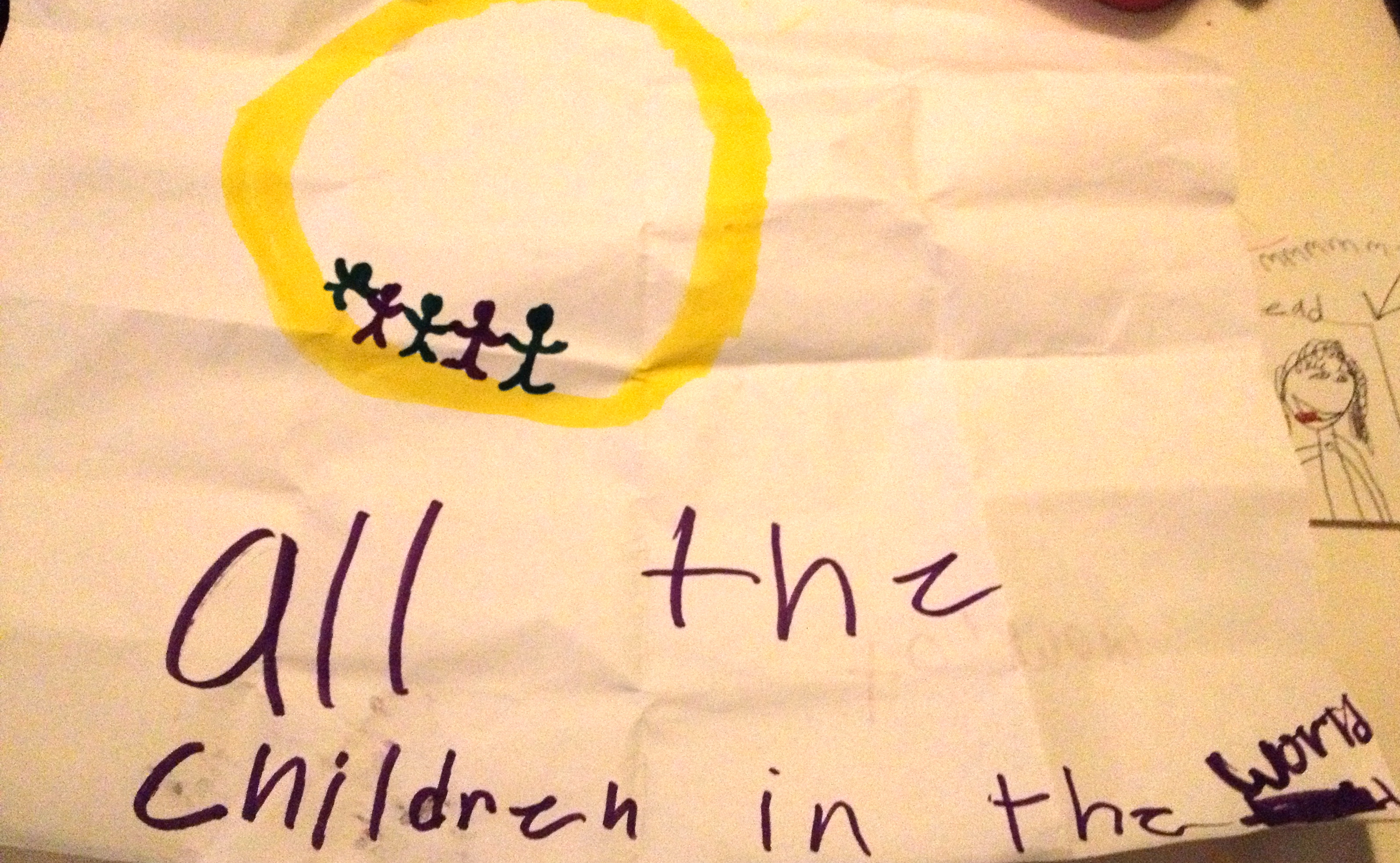
ADDITIONAL RESOURCES: You’re on your way to a great Human Rights Day! If you are a classroom teacher or homeschooling your kids (or if you just want to dig deeper), you can find tons more ideas through the following resources:
United Nations Cyber Schoolbus – human rights activities and information about the United Nations’ work
ABC – Teaching Human Rights – practical activities in English, French, Russian, Arabic, Chinese, and Spanish from the UN Office of the High Commissioner for Human Rights
The Advocates for Human Rights’ Discover Human Rights Institute – human rights education lesson plans and curriculum
Human Rights Here and Now – human rights lesson plans and resources
Raising Children With Roots, Rights and Responsibilities – activities for preschool and young elementary children
Do you plan to mark Human Rights Day with your kids?
This is an original post written for World Moms Blog by Jennifer prestholdt.

Jennifer Prestholdt is a lawyer and the Deputy Director of The Advocates for Human Rights, a volunteer-based human rights organization that works locally, nationally and internationally. Her work in human rights takes her around the world, but she spends most of her time in Minneapolis, MN, where she lives with her children (two sons and one daughter), her husband, an elderly cat and a dwarf hamster.
As Jennifer’s kids are now all in school (1st, 4th and 6th grades), she is finally finding more time to do the things that she used to love to do, especially running, writing and knitting. Jennifer loves to travel and has had the dubious distinction of having been accidentally locked in a bathroom on five continents so far. Australia and Antarctica await!
In January 2011, Jennifer made a New Year’s Resolution to start writing about her experiences in order to share with her children the lessons learned from 15 years of work in human rights. The result is her personal blog, The Human Rights Warrior. The name comes from her son Simon, who was extremely disappointed to learn that his mother is a lawyer, not a warrior.
You can find her on her blog The Human Rights Warrior or on Twitter @Jprestholdt.
More Posts

by Tara Bergman (USA) | Dec 6, 2013 | Cooking, Death and Dying, Family, Food, Grandparent, Home, Siblings, Tara B., World Motherhood
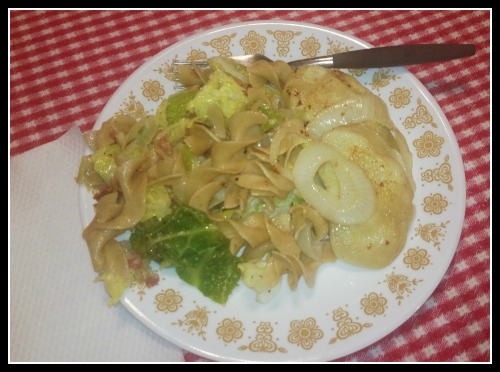 Recently, my Gram passed away at 92 years old. She was remarkable in many ways, but her cooking is one of the things that stood out to anyone who knew her. It wasn’t just what she made, which was always delicious, but it was also how she made it.
Recently, my Gram passed away at 92 years old. She was remarkable in many ways, but her cooking is one of the things that stood out to anyone who knew her. It wasn’t just what she made, which was always delicious, but it was also how she made it.
My Gram was very much the matriarch of our family, and for years she hosted most of the holiday meals in her half of a double block home. She would get up at 3 AM to start cooking everything from scratch.
She was Polish, so many of her dishes came from that influence, although she could also whip out an amazing lasagna or cheesecake. Whatever was on the menu, she would work for days preparing and then serve us all in her dining room while she ate in the kitchen. (more…)
Tara is a native Pennsylvanian who moved to the Seattle area in 1998 (sight unseen) with her husband to start their grand life adventure together. Despite the difficult fact that their family is a plane ride away, the couple fell in love with the Pacific Northwest and have put down roots. They have 2 super charged little boys and recently moved out of the Seattle suburbs further east into the country, trading in a Starbucks on every corner for coyotes in the backyard. Tara loves the outdoors (hiking, biking, camping). And, when her family isn't out in nature, they are hunkered down at home with friends, sharing a meal, playing games, and generally having fun. She loves being a stay-at-home mom and sharing her experiences on World Moms Network!
More Posts

by Katinka | Dec 5, 2013 | 2013, Adoption, Adoptive Parents, Being Thankful, Belgium, Childhood, Cultural Differences, Culture, Education, Eye on Culture, Family, International, Kids, Life Lesson, Motherhood, Multicultural, Netherlands, Parenting, Penguin and Panther, Politics, Siblings, Traditions, Turkey, United Nations, World Events, World Motherhood, Younger Children
 As an adoptive mother of an Ethiopian Panther, I’ve grown an extra pair of antennas when it comes to racism.
As an adoptive mother of an Ethiopian Panther, I’ve grown an extra pair of antennas when it comes to racism.
Truly, a lot of really nice people distinguish my daughter from other children, based on her color. Even if it is meant to defend her, like calling me disgusting for letting her carry the groceries, it basically still is hidden racism. Should I tell her that people believe she shouldn’t be helping me out because it reminds them of slavery while her white brother is allowed to do the same chores? I’d rather have people call me names than let them wreck my daughter’s self esteem.
However, as I’m writing this, there is a HUGE racism debate going on in Belgium and even worse in The Netherlands, where it all started. And despite my racism antennas, I just can’t fully agree with the racism-yellers this time. Not even if they yell all the way from some United Nations office.
The debate is all about the ancestor of Santa Claus: Sinterklaas. You can read here about how Santa Claus evolved from our Sinterklaas, or Saint Nicholas, who is actually believed to be Turkish, who resides in Spain, has a white horse called Bad-Wheater-Today (Belgium) or Amerigo (The Netherlands), and celebrates his December birthday by coming over to our countries and surprising children with presents.
In the Netherlands he comes over on the evening of December 5th. Later that night, he comes to Belgium and delivers toys and sweets to be found in the children’s shoes on the morning of the 6th. It’s really a children’s celebration, full of magic and anticipation. You will bump into him just about everywhere during November.
Now, because Sinterklaas is getting old and forgetful, and has a lot of work to do within 24 hours, he has helpers. These helpers are all black, and hence all called ‘Black Peter’ (Zwarte Piet).
And that’s where all the accusative fingers point.
Indeed, this tradition can be seen as offensive. I, for a fact, believe it is partly based on a slavery and stereotype-loaded past, and a lot of people agree with me. Black Peter has long been depicted as a bit slow, barbaric (kidnapping and hitting the naughty children), dressed in clownish clothes, with stout lips and being submissive to his white boss.
Of course I agree this is an awful, insulting picture to brainwash our children with during the big Sinterklaas-Awaiting-Month-of -November. I also agree an outsider would be shocked, when he meets Sinterklaas and his Black Peters for the first time, especially if oblivious to the folklore. And I honestly understand and feel the offense people take.
For me personally, Sinterklaas has me cringing with bittersweetness ever since I found out about his racist taint. I’m not even particularly fond of the Sinterklaas tradition anymore.
However, I also don’t agree that we are teaching our children racism, nor paying ode to slavery by honoring this tradition every year. Not any more, that is.
Since the 1990’s, we have a children’s holiday special on TV portraying the real story. Children are elegantly taught Black Peter is black – and not brown/colored/african – because he came down the chimney. No more, no less. Nobody really tries to explain why his clothes didn’t get black during his journey down the chimney.
It is just part of the mystery, just like Bad-Wheater-Today walking on rooftops or Sinterklaas having this enormous book in which the good and bad behavior of every single child is listed. It doesn’t make sense, but children buy it anyway.
In this TV-special, Sinterklaas is depicted as a bit senile. In fact his Black Peters are now the smart ones, all with different names according to their function or character. A bit like the Smurfs, and everyone likes the Smurfs, right?
For the past 20+ years, this special comes on every November. Along the way, children started to grow more afraid of this very strict and grumpy old man than of his joyous, candy throwing helpers. The Black Peters became the true friends of our children. And every Belgian child you ask about Black Peter’s color now, will patiently tell you the chimney-story.
To me, this shows our tradition is evolving from, I admit, a racist past, towards a new story. Just like it evolved into Santa Claus overseas—who, by the way, appears to imprison a whole lot of innocent, little people in a Siberia-like, harsh environment without paying them for their round-the-clock labor.
Therefore, I trust society may even evolve towards a tradition of White Peters in a few more years or decades. After all, with more and more houses being built without huge chimneys, we will sooner or later find out that Peter’s color is fading, won’t we?
I’m hoping that by the time this post runs, all the petitions –pro and con–the social media frenzy, any UN investigations and any public manifestations, will be over and done with. I truly hope no-one got hurt along the way, and that both camps have reached a certain level of understanding towards each other by the time Saint Nicholas wants to celebrate his birthday.
Because, you know, my children are already expecting Sinterklaas to send one of his Peters down our chimney on the 6th of December. Especially my very dark daughter is impatiently awaiting. I’d hate to disappoint her if he decided not to come this year, because he’s afraid to be called a racist. She would definitely not understand, mainly because she doesn’t see any resemblance between Black Peter and herself.
I’m confident Sinterklaas will make it, though. We are both alike, Sinterklaas and me. We’re already used to people calling us racist slave handlers. And we both know better than that.
Did you know about Santa Claus’s European past? How would you feel if he had black helpers instead of elves?
This is an original post to World Moms Blog by K10K from The Penguin and The Panther.
The picture in this post is credited to Sinterklaas Himself, who published it on Wikipedia, while undercover as Gaby Kooiman, under GNU Free Documentation License.
If you ask her about her daytime job, Katinka will tell you all about the challenge of studying the fate of radioactive substances in the deep subsurface. Her most demanding and rewarding job however is raising four kids together with five other parents, each with their own quirks, wishes and (dis)abilities. As parenting and especially co-parenting involves a lot of letting go, she finds herself singing the theme song to Frozen over and over again, even when the kids are not even there...
More Posts
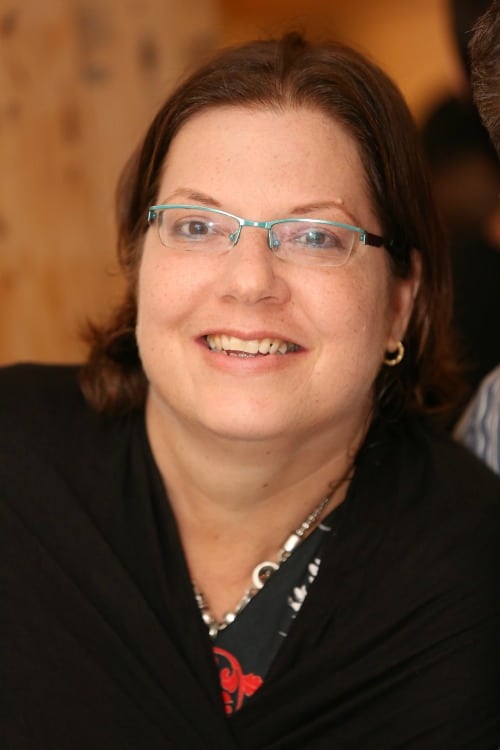
by Susie Newday (Israel) | Dec 4, 2013 | 2013, Body Image, Cancer, Death and Dying, Family, Inspirational, Interviews, Israel, Life Lesson, Parenting, Relationships, Susie Newday, World Interviews, World Motherhood

Neta sat down with World Mom contributor, Susie Newday in Israel to talk about living her life with metastasis breast cancer.
This is part two of our contributor and oncology nurse, Susie Newday’s, moving and in depth interview on breast cancer with her good friend. Grab a cup of something warm, and come be a fly on the wall with us, as two friends discuss living with metastatic breast cancer. There is something for us all to learn.
(To catch up, click here to read Part I, click here to read Part II, click here to read Part III.)
Susie: What has changed now after your husband has also been diagnosed with metastatic colon cancer?
Neta: When two parents are sick it’s something completely different. In the past when I used to feel unwell or weak, I could allow myself to go to bed because I knew he was around. In the evenings he would be with the kids and I didn’t have to be there. They saw me at lunchtime when I gave them lunch, they saw me in the afternoon and it was no big deal for my husband to make the kids dinner and be there with them. Now there isn’t that option. He goes to work. He’s also exhausted in the evenings and he climbs into bed. In the beginning he had more energy but for the past few months he’s been exhausted when he gets home from work. I don’t have back-up anymore. It’s very hard without backup because you can’t allow yourself to be tired for even one day. I have to function at a different level than what I had been functioning at before.
S: Did you tell your children when you were diagnosed?
N: Yes. All three times; when I was first diagnosed, when I had the recurrence and when my husband was diagnosed. We consulted with a psychologist about how to tell the kids. We told them the truth. We told the boys and girls separately because there is an age difference between them. I don’t remember the first conversation being very traumatic. The kids were also younger. They didn’t really understand. They were surprised and it was the first time they had heard the word cancer. We told them that mommy has breast cancer and it’s not so bad, a lot of people get better. I told them that I’m going to get treatment and I have the best doctors who are going to help me recover. There is going to be a period of time that I am going to get strong treatment so the cancer will die. I don’t remember any tough reactions or trauma.
When the cancer came back it was a little tougher because the kids were already older. My two older children cried. I didn’t tell them it was terminal. I was told not to say that because no one knows how much time I have so not to limit it by time. I told them that the cancer was back and that this time it was in my bones as well and that the doctors had found the reason for my back pain. I told them I was going to go for treatments now so that I can cope with the cancer. Again I told them that I had good doctors and that I was in good hands.
When my husband got sick less than a year ago, telling the kids was traumatic. When we told our older daughters the younger one sat there and cried. My older daughter was angry and yelled What??? It’s not fair!! You’re sick already. Now daddy? She cried and yelled at the same time. It was a very tough conversation. She already understood as this was the third conversation she had gone through. I started to cry when she started screaming “it’s not fair”. My husband spoke, my younger daughter and I cried silently and my older daughter cried and screamed. The conversation with the younger boys was easier, they didn’t really understand as much. They know that daddy has cancer in his belly and mommy has cancer in her bones
I worry a lot about the kids because obviously it’s very hard on them. My oldest is very angry with God. She’s not willing to pray anymore. I understand her anger. I’m angry too. How can this happen to both parents? With my second daughter I see more sadness.
We haven’t really had any more outright conversations about our illnesses with our kids. There is the day to day coping like if I’m not feeling well then my husband will put the kids to sleep. Or visa versa. So the kids know when we’re not feeling okay. The other day my youngest who is 6 1/2 asked me how much longer are you guys going to be sick? When are you going to be healthy again? I explained to him that it is a very tough disease and it takes a very very very long time to get better. I can’t explain to him that you don’t get well.
S: Physically, how do you manage? With yourself, with the house, the kids.
N: It’s not easy. In areas that I feel are less meaningful and more technical, we have help. We have someone who cooks and someone who cleans. We had someone to fold laundry and we will probably use her again. We used to have a babysitter in the afternoons. Now we have the kids in afternoon programs. In the areas I can release and get help, I have done so. There are certain things I’m trying to keep as is, like having everyone sit down for dinner together. I try to make sure that there is always food in the house. It comforts me to know that there is food in the house and there is what to eat.
It’s a pity to waste energy on things that are not meaningful. I save the energy for things that make me feel good, like if the kids want to go shopping, even though it’s already tough for me to walk a lot.
S: What has been the one most difficult or scary thing that you have gone through since you were first diagnosed with cancer?
N: When I lost my eyesight. Not being able to see was really scary. You lose your connection to the world. I was also very confused. It was a real trauma. After my eyesight came back I was afraid to fall asleep at night because I was afraid that maybe when I woke up in the morning I wouldn’t be able to see again. In general, the scariest thing is losing your abilities. Suddenly, I won’t be able to see. Suddenly, I won’t be able to walk. Basically, it’s about losing your independence. It’s very important to me to be independent. I’m very afraid of becoming dependent. Losing my eyesight meant losing my independence. I needed people to be with me, to go everywhere with me. It was a complete lack of control. Seeing is such an important sense and suddenly you lose it. You only hear and you lose your ability to do things. For me the fear of losing my independence was the worst. If you ask my husband, for him the fear of me being confused was worse. He was able to imagine being with someone who couldn’t see. He didn’t know how he could manage with someone who was confused. I remember the blindness as traumatic, my husband remembers my confusion as the traumatic part.
S: A lot of people want to support friends or family who have cancer but we often say or do the wrong things. Do you have any advice about what we should or shouldn’t do?
N: There is a lot of good will and a lot of people want to help but you have to remember to respect the person and the household. Like in the beginning, friends wanted to come and fold laundry for me but I didn’t want anyone to. That was something I could handle on my own. Also when people were cooking for me in the beginning, there was a constant stream of people coming in and out of the house bringing food. You feel like you have no control over what is going on in your house.
It was very important for us to return the sense of control over our household to ourselves, to conserve the sense of independence of our family. Our good friends who were a constant presence in our house beforehand did stay a constant and that was fine. Those friends also knew to ask beforehand. I told friends and family when it was okay to visit.
S: Sometimes, we say no because we don’t want to trouble other people and when someone insists on doing something anyway, sometimes in the end it is a big help and appreciated.
N: It is possible. Like the few times we’ve had company over in the past year and they wanted to wash dishes and out of manners I told them no but they did it anyways, it was appreciated.
S: Is there anything someone said to you that really bothered you?
N: It really annoyed be when people told me “Be Strong”. What? Like I wasn’t working on that enough? Another sentence was ” I’m sure it will pass.” What exactly will pass? Where is it going to pass to? I am sure there were other things but I don’t remember anymore.
S: Were there people who found it hard to talk to you afterwards?
N: I don’t think so. People tell me that because I’m so open and speak so freely that it wasn’t so hard to talk to me. There were some people who told me they were afraid to talk to me at first but when they did speak to me the conversation flowed. I talk to people about what is going on. I don’t hide it.
S: It must be quite a financial burden to have all the help with the cooking and cleaning and other things.
N: It is. I’m not working anymore and I get a small government stipend. My husband is still working which is lucky. If he has to stop working, the financial side would be very tough.
S: So what things would you suggest that people do if they want to help?
N: Always ask. What is right for me might not be right for someone else. First ask if they want the help. Like with food, say “I really want to make something for you guys, can I?” If you got a yes, then offer a choice of what to bring so the person can pick something that is right for their family. Make sure to ask first because maybe they really don’t want anything. To bring forcefully is also not good because it infringes on their domain. It also obviously depends on how close you are to the person. To bring without asking doesn’t seem to be respectful of the home.
S: Any tips about cancer in general?
N: Go get checked! Every woman needs to be checked even if there’s no family history that you know about. Just go get checked. I really don’t know why they don’t start the screening from a younger age. I was diagnosed at age 38. If they would have done routine scanning from an earlier age they would have caught my cancer sooner and I would be in a very different position right now. I found it on my own and I found it too late. The difference between early diagnosis and later diagnosis is huge. After I was diagnosed, all my friends went to get checked.
You have to gather strength. We don’t know what life holds for us. Who ever imagined that I would have breast cancer and bone metastases? If you would have asked me six years ago, that wasn’t even an option. I didn’t even think of it. When we get sick, it will always catch us by surprise. We’re never ready to be sick. Even if we know there is a possibility, we are never truly ready. When it happens you have to rally a lot of strength and understand that we can’t control our lives and we just have to do our best. That’s what I try to do. I’m fighting the best I can. I can’t do more than that. Ever new day I try to find the energy to fight and I say to myself I’m fighting this. When you succeed in having a good day, it gives you a lot of strength to continue on. If you don’t do that you can sink emotionally and that can’t possibly be healthy. I think that the reason I am not sinking into depression is because I’m invested in doing.
Sometimes it’s better not to think too much and to just be busy. When I had time to think it was really not good for me.
S: What is your wish for world moms?
N: I wish for either a way to catch cancer early or for better drugs to fight it and cure it or at the minimum turn it into a chronic disease that you don’t die from. Breast cancer rates are way too high.
I wish for mothers around the world to enjoy every minute of their parenting because we never know when it will end. I was sure that I would raise my children and live to see my grandkids grow as well. Today, I am not sure I will even see my kids grow up.
We never know when we will leave this world. Don’t push things off. Don’t say when I retire I will do this or that. Parenting is a very precious gift that has no replacement and we don’t know how long we will be parents or grandparents for. Take advantage of now and don’t push things off. We went on a family trip overseas a while back and I am so happy we did. It was a great experience. It was better than having a new kitchen done, buying a new car or having the garden done.
The experience of motherhood, parenthood, of family is the most precious experience in the world, so invest in that and less in material things.
It took a lot of openness and strength on Neta’s part to do this interview series. I want to thank her from the bottom of my heart for having the courage to share her story so that other people might benefit from it.
As far as helping people who are going through any difficult time, be it medical or emotional, I think this article about the “comfort in, dump out” theory is a must read.
Cancer can happen to everyone. Listen to your body, treat it well and educate yourself about cancer symptoms. Learn not just about breast cancer symptoms (which are varied) but also the symptoms of ovarian cancer, GI cancer, lung cancer, pancreatic cancer and all the other cancers out there. Ask your parents about your family medical history. Do the recommended screening tests that are available to you because early detection of any cancer makes a hell of a difference.
Most of all enjoy every minute of your life because there are people out there who are dying for more time.
Who hasn’t yet gotten screened and is now going to get themselves checked?
Susie Newday is a happily-married American-born Israeli mother of five. She is an oncology nurse, blogger and avid amateur photographer.
Most importantly, Susie is a happily married mother of five amazing kids from age 8-24 and soon to be a mother in law. (Which also makes her a chef, maid, tutor, chauffeur, launderer...) Susie's blog, New Day, New Lesson, is her attempt to help others and herself view the lessons life hands all of us in a positive light. She will also be the first to admit that blogging is great free therapy as well. Susie's hope for the world? Increasing kindness, tolerance and love.
You can also follow her Facebook page New Day, New Lesson where she posts her unique photos with quotes as well as gift ideas.
More Posts - Website
Follow Me:





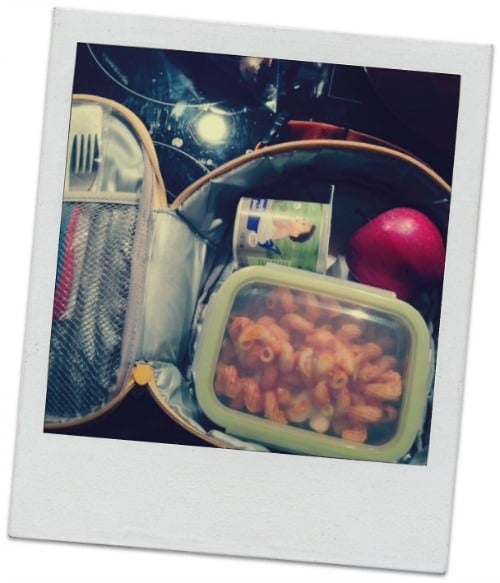
by Maman Aya (USA) | Nov 29, 2013 | Communication, Cooking, Education, Family, Health, Kids, Motherhood, Nutrition, Parenting, School, USA, World Motherhood, Younger Children
 For the last three years I have had to prepare lunch for my son to take to school with him. I always sent him a warm meal, in a thermos, usually comprised of leftovers or something that I would cook for him before school in the morning. I stood in the kitchen lovingly cooking his lunch every day. The only rules the school had were no nuts or candy. OK – easy enough, considering I always include fresh fruit and a salad and since I am conscience to buy organic whenever I can, I knew that he was having a balanced meal that was healthy and included some of the vital nutrients that his growing body needed.
For the last three years I have had to prepare lunch for my son to take to school with him. I always sent him a warm meal, in a thermos, usually comprised of leftovers or something that I would cook for him before school in the morning. I stood in the kitchen lovingly cooking his lunch every day. The only rules the school had were no nuts or candy. OK – easy enough, considering I always include fresh fruit and a salad and since I am conscience to buy organic whenever I can, I knew that he was having a balanced meal that was healthy and included some of the vital nutrients that his growing body needed.
This September, he started first grade, and the school rules changed. I am no longer allowed to pack his lunch, and he HAS to eat from the cafeteria.
The first graders need to learn responsibility and proper nutrition, so part of that lesson is allowing them to choose their food themselves.
I wouldn’t mind if they had the same organic, fruit and vegetable laden options that I would provide, but they don’t. Apparently they get organic “when they can”, and they try to make the parents feel better by saying that there is a “salad bar” available to the kids with baby carrots, tomatoes, cucumbers, hard boiled eggs and such available. They also have a “sandwich bar” where the kids can have their choice of bread like white sliced bread, bagels, whole wheat sliced bread, etc. (my kids have never had white sandwich bread in their life). They have cold cuts (I don’t ever buy cold cuts at home, since they are full of nitrates and sodium, if anything I would get fresh cooked chicken or turkey and slice it for a sandwich), and butter and jam available. They always have some kind of breakfast cereal (non-organic, mind you), and milk, juice, chocolate milk available to drink. Now to be fair, they have a “hot food bar” available as well, where the kids have a selection of hot foods available usually consisting of some protein, starch, vegetable, a soup, perhaps some pizza or pasta. (more…)

Maman Aya is a full-time working mother of 2 beautiful children, a son who is 6 and a daughter who is two. She is raising her children in the high-pressure city of New York within a bilingual and multi-religious home.
Aya was born in Canada to a French mother who then swiftly whisked her away to NYC, where she grew up and spent most of her life. She was raised following Jewish traditions and married an Irish Catholic American who doesn’t speak any other language (which did not go over too well with her mother), but who is learning French through his children. Aya enjoys her job but feels “mommy guilt” while at work. She is lucky to have the flexibility to work from home on Thursdays and recently decided to change her schedule to have “mommy Fridays”, but still feels torn about her time away from her babies. Maman Aya is not a writer by any stretch of the imagination, but has been drawn in by the mothers who write for World Moms Blog. She looks forward to joining the team and trying her hand at writing!
More Posts

by Susie Newday (Israel) | Nov 28, 2013 | 2013, Being Thankful, Family, Israel, Multicultural, Religion, Spirituality, Susie Newday, Traditions, World Moms Blog, World Motherhood
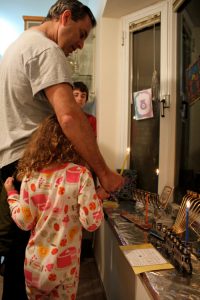 This year, we have a unique occurrence, Thanksgivvukah. (Yes, I know that by now the phrase is probably coming out of your ears.) There are debates as to whether Thanksgivukkah is a once in a 70,000 year event or a once in a decade event. Either way, the last time it happened was 1888 and I doubt any of us will be around for the next one.
This year, we have a unique occurrence, Thanksgivvukah. (Yes, I know that by now the phrase is probably coming out of your ears.) There are debates as to whether Thanksgivukkah is a once in a 70,000 year event or a once in a decade event. Either way, the last time it happened was 1888 and I doubt any of us will be around for the next one.
The Jewish month of Kislev, the month in which Chanukkah occurs, is considered a month of miracles. It’s a month that serves as a reminder to actively do something to banish the darkness from our lives and be a light unto others and the world.
Last night was the first night of the 8 day Jewish holiday of Chanukkah and tonight is the American holiday of Thanksgiving.
I’m grateful for the unique convergence of the two holidays because I think that the message of Chanukah and Thanksgiving is really the same; practice gratitude, practice kindness and be the love you wish to receive. That is the only way to banish the darkness from this world and spread the glow of goodness to the farthest corners of the earth.
So in honor of Thanksgivukkah here are some ideas for making the world a better place.
Embrace the Thanksgiving tradition of practicing gratitude, but go one step further and practice it daily. Be grateful for all the gifts in your life be they big or small.
Embrace the Chanukkah tradition of spreading your light, your inner light, far and wide. I think that the best way to combine gratitude and being a light unto the world is to get into the habit of doing acts of kindness.
So here are ideas for 8 acts of kindness for 8 days of Chanukah, or for that matter, any day of the year.
Smile at everyone you pass
A smile costs you absolutely nothing and you never know what a potentially big impact a single smile can have on someone else’s day.
Write a letter to someone who has made a difference in your life
People don’t always realize the impact they have had on someone. Why not let them know?
Give someone a big hug
People need physical contact and hugs make (most) people feel good.
Forgive someone
This is actually kindness that benefits you the most because forgiving is really for the forgiver.
Ask if you can help
Some people don’t know how to ask for help or don’t think there is anyone who can help them. It can be as simple as asking a parent with a screaming child in a grocery store if they need help or lending your expertise to someone who can benefit from it.
Offer to babysit for someone
Every parent knows that as much as we love our kids, sometimes we need some time apart. Give the gift of sanity to another parent.
Leave a note in a library book
A little note of kindness and encouragement left inside a library book can make all the difference to a struggling parent. Take a look at this amazing note my sister found tucked into the pages of a parenting book.
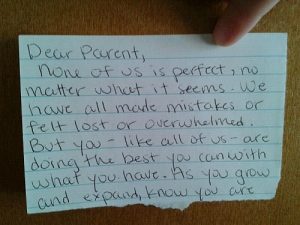
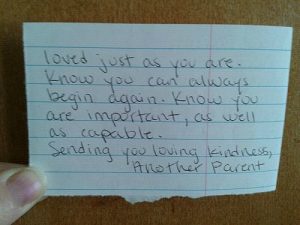
Listen, truly listen
Each and every one of us can learn how to listen better. Listen without thinking about what you are going to reply. Listen with an open mind and most importantly, an open heart. As Buddha said: “A thousand candles can be lit from the flame of one candle, and the life of the candle will not be shortened. Happiness can be spread without diminishing that of yourself.”
So Happy Chanukkah and Thanksgiving to everyone. This holiday season go out and be the light and light the way. Be the person whose act of kindness or love inspires other people to pay it forward and spread kindness and love. One person DOES have an impact, it all starts with the will to make a change.
What is your favorite act of kindness?
This is an original post by World Moms Blog Africa & Middle East Regional Editor, Susie Newday in Israel.
Photo credit to the author. (And to her sister.)
And just for fun, here is a Thanksgivukkah spoof. (If you don’t understand some of the words, they are probably in Hebrew. Just ask me in the comments and I will translate them if you want.)
Susie Newday is a happily-married American-born Israeli mother of five. She is an oncology nurse, blogger and avid amateur photographer.
Most importantly, Susie is a happily married mother of five amazing kids from age 8-24 and soon to be a mother in law. (Which also makes her a chef, maid, tutor, chauffeur, launderer...) Susie's blog, New Day, New Lesson, is her attempt to help others and herself view the lessons life hands all of us in a positive light. She will also be the first to admit that blogging is great free therapy as well. Susie's hope for the world? Increasing kindness, tolerance and love.
You can also follow her Facebook page New Day, New Lesson where she posts her unique photos with quotes as well as gift ideas.
More Posts - Website
Follow Me:












 Recently, my Gram passed away at 92 years old. She was remarkable in many ways, but her cooking is one of the things that stood out to anyone who knew her. It wasn’t just what she made, which was always delicious, but it was also how she made it.
Recently, my Gram passed away at 92 years old. She was remarkable in many ways, but her cooking is one of the things that stood out to anyone who knew her. It wasn’t just what she made, which was always delicious, but it was also how she made it.









 For the last three years I have had to prepare lunch for my son to take to school with him. I always sent him a warm meal, in a thermos, usually comprised of leftovers or something that I would cook for him before school in the morning. I stood in the kitchen lovingly cooking his lunch every day. The only rules the school had were no nuts or candy. OK – easy enough, considering I always include fresh fruit and a salad and since I am conscience to buy organic whenever I can, I knew that he was having a balanced meal that was healthy and included some of the vital nutrients that his growing body needed.
For the last three years I have had to prepare lunch for my son to take to school with him. I always sent him a warm meal, in a thermos, usually comprised of leftovers or something that I would cook for him before school in the morning. I stood in the kitchen lovingly cooking his lunch every day. The only rules the school had were no nuts or candy. OK – easy enough, considering I always include fresh fruit and a salad and since I am conscience to buy organic whenever I can, I knew that he was having a balanced meal that was healthy and included some of the vital nutrients that his growing body needed.






